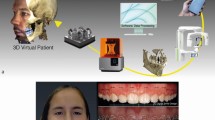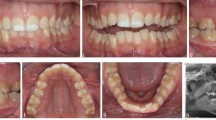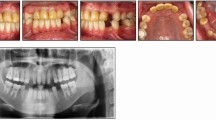Abstract
Dentistry has changed significantly in the last two decades. Interdisciplinary treatment planning strives to deliver the highest quality of care through innovative collaborations among providers and the patient. The complexity of the care and challenges in interdisciplinary team communications are primary hurdles. We discuss five principles of interdisciplinary orthodontic-restorative treatment and outline a four-step interdisciplinary treatment planning process, starting with a comprehensive clinical examination to collect subjective and objective data. Diagnostic records, including 3D models, videos, 2D photos, questionnaires, and reports, are then evaluated to develop a problem list and treatment objectives. Treatment simulation is used to envision the outcome and guide the formulation of an orthodontic-restorative treatment plan. The plan can be broken down into stages, depending on the condition of the teeth and the planned restorative treatment. The challenges and opportunities presented by digital dentistry and the potential for more efficient interdisciplinary treatment are presented. In sum, this article provides an overview of the principles and framework for interdisciplinary orthodontic-restorative treatment, emphasising the importance of collaboration, communication and comprehensive treatment planning.
Key points
-
Orthodontic-restorative interdisciplinary treatment planning includes four steps. Step one is the clinical examination and collecting diagnostic records. Step two is to evaluate the diagnostic data including 3D images. Step three is to create a problem list development. Finally, an interdisciplinary treatment plan is formulated.
-
Digital technology, especially dental 3D printing, can be used in treatment planning during the discussion among the interdisciplinary team and the patient.
-
Asynchronous interdisciplinary team communication (eg screen recordings) eliminates various logistical barriers in orthodontic-restorative interdisciplinary treatment.
This is a preview of subscription content, access via your institution
Access options
Subscribe to this journal
Receive 24 print issues and online access
$259.00 per year
only $10.79 per issue
Buy this article
- Purchase on SpringerLink
- Instant access to full article PDF
Prices may be subject to local taxes which are calculated during checkout





Similar content being viewed by others
References
Brown M, Wiltshire W, de Sa Leitao Pinheiro F H, Schönwetter D J. Adult patient preference for an orthodontic care provider in Canada. Am Journal of Orthod and Dentofacial Orthoped 2022; DOI: 10.1016/j.ajodo.2021.04.035.
Kokich V G, Spear F M. Guidelines for managing the orthodontic-restorative patient. Sem Orthod 1997; 3: 3-20.
West J D, O'Connor R V, Cook D H. The Interdisciplinary Referral. Dent Today 2002; 21: 98-105.
Murphy M T. Collaborative interdisciplinary agreements: a new paradigm in laboratory and specialist communication and patient care. J Am Dent Assoc 2006; 137: 1164-1167.
Dalio R. Principles. New York: Simon & Schuster, 2018.
Tweed C H. Was the development of the diagnostic facial triangle as an accurate analysis based on fact or fancy? Am J Orthod 1962; 48: 823-840.
Caton J G, Armitage G, Berglundh T et al. A new classification scheme for periodontal and peri-implant diseases and conditions - Introduction and key changes from the 1999 classification. J Clin Periodontol 2018; 45: S1-S8.
American Dental Association. Caries Risk Assessment, Management. Available at https://www.ada.org/resources/ada-library/oral-health-topics/caries-risk-assessment-and-management (accessed March 2024).
Okeson J P. Evolution of occlusion and temporomandibular disorder in orthodontics: past, present, and future. Am J Orthod Dentofacial Orthop 2015; 147: S216-S223.
Sarver D, Jacobson R S. The aesthetic dentofacial analysis. Clin Plast Surg 2007; 34: 369-394.
Schuyler C H. The function and importance of incisal guidance in oral rehabilitation 1963. J Prosthet Dent 2001; 86: 219-232.
Bud E S, Bică C I, Păcurar M et al. Observational Study Regarding Possible Side Effects of Miniscrew-Assisted Rapid Palatal Expander (MARPE) with or without the Use of Corticopuncture Therapy. Biology (Basel) 2021; 10: 187.
Kesling H D. The Philosophy of the Tooth Positioning Appliance. Am J Orthod Oral Surg 1945; 31: 297-304.
Hou D, Capote R, Bayirli B, Chan D C N, Huang G. The Effect of Digital Diagnostic Setups on Orthodontic Treatment Planning, Am J Orthod Dentofacial Orthop 2020; 157: 542-549.
Grembowski D, Milgrom P, Fiset L. Dental Decision making and Variation in Dentist Service Rates. Soc Sci Med 1991; 32: 287-294.
Author information
Authors and Affiliations
Contributions
RK: Developed the outline of the manuscript and wrote the paper. Created figures and flowcharts presented. VR: Developed the outline of the manuscript. Participated in various discussions with RK on the information presented in the manuscript. Proofread and edited the manuscript. RK and VR: Contributed to treatment planning of presented cases.
Corresponding author
Ethics declarations
The authors declare no conflicts of interest. Written consent to publish has been obtained for clinical photographs.
Rights and permissions
Springer Nature or its licensor (e.g. a society or other partner) holds exclusive rights to this article under a publishing agreement with the author(s) or other rightsholder(s); author self-archiving of the accepted manuscript version of this article is solely governed by the terms of such publishing agreement and applicable law.
About this article
Cite this article
Khosravi, R., Ramos Jr, V. Principles of interdisciplinary orthodontic and restorative treatment. Br Dent J 237, 326–331 (2024). https://doi.org/10.1038/s41415-024-7790-0
Received:
Revised:
Accepted:
Published:
Issue date:
DOI: https://doi.org/10.1038/s41415-024-7790-0
This article is cited by
-
Good, fast and cheap
British Dental Journal (2024)



